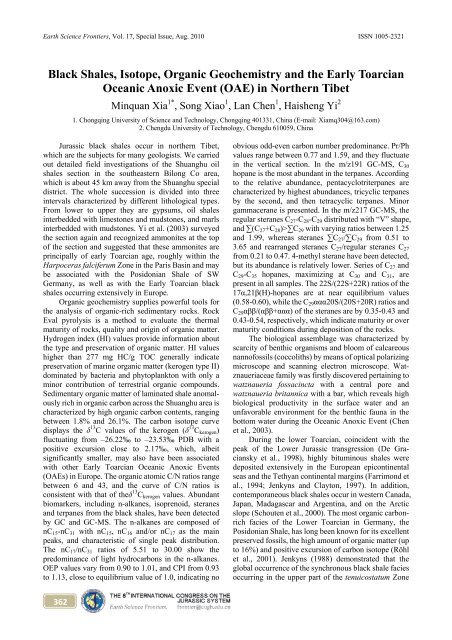in Jurassic and Cretaceous Stratigraphy
in Jurassic and Cretaceous Stratigraphy
in Jurassic and Cretaceous Stratigraphy
Create successful ePaper yourself
Turn your PDF publications into a flip-book with our unique Google optimized e-Paper software.
Earth Science Frontiers, Vol. 17, Special Issue, Aug. 2010 ISSN 1005-2321<br />
Black Shales, Isotope, Organic Geochemistry <strong>and</strong> the Early Toarcian<br />
Oceanic Anoxic Event (OAE) <strong>in</strong> Northern Tibet<br />
362<br />
M<strong>in</strong>quan Xia 1* , Song Xiao 1 , Lan Chen 1 , Haisheng Yi 2<br />
1. Chongq<strong>in</strong>g University of Science <strong>and</strong> Technology, Chongq<strong>in</strong>g 401331, Ch<strong>in</strong>a (E-mail: Xiamq304@163.com)<br />
2. Chengdu University of Technology, Chengdu 610059, Ch<strong>in</strong>a<br />
<strong>Jurassic</strong> black shales occur <strong>in</strong> northern Tibet,<br />
which are the subjects for many geologists. We carried<br />
out detailed field <strong>in</strong>vestigations of the Shuanghu oil<br />
shales section <strong>in</strong> the southeastern Bilong Co area,<br />
which is about 45 km away from the Shuanghu special<br />
district. The whole succession is divided <strong>in</strong>to three<br />
<strong>in</strong>tervals characterized by different lithological types.<br />
From lower to upper they are gypsums, oil shales<br />
<strong>in</strong>terbedded with limestones <strong>and</strong> mudstones, <strong>and</strong> marls<br />
<strong>in</strong>terbedded with mudstones. Yi et al. (2003) surveyed<br />
the section aga<strong>in</strong> <strong>and</strong> recognized ammonites at the top<br />
of the section <strong>and</strong> suggested that these ammonites are<br />
pr<strong>in</strong>cipally of early Toarcian age, roughly with<strong>in</strong> the<br />
Harpoceras falciferum Zone <strong>in</strong> the Paris Bas<strong>in</strong> <strong>and</strong> may<br />
be associated with the Posidonian Shale of SW<br />
Germany, as well as with the Early Toarcian black<br />
shales occurr<strong>in</strong>g extensively <strong>in</strong> Europe.<br />
Organic geochemistry supplies powerful tools for<br />
the analysis of organic-rich sedimentary rocks. Rock<br />
Eval pyrolysis is a method to evaluate the thermal<br />
maturity of rocks, quality <strong>and</strong> orig<strong>in</strong> of organic matter.<br />
Hydrogen <strong>in</strong>dex (HI) values provide <strong>in</strong>formation about<br />
the type <strong>and</strong> preservation of organic matter. HI values<br />
higher than 277 mg HC/g TOC generally <strong>in</strong>dicate<br />
preservation of mar<strong>in</strong>e organic matter (kerogen type II)<br />
dom<strong>in</strong>ated by bacteria <strong>and</strong> phytoplankton with only a<br />
m<strong>in</strong>or contribution of terrestrial organic compounds.<br />
Sedimentary organic matter of lam<strong>in</strong>ated shale anomal-<br />
ously rich <strong>in</strong> organic carbon across the Shuanghu area is<br />
characterized by high organic carbon contents, rang<strong>in</strong>g<br />
between 1.8% <strong>and</strong> 26.1%. The carbon isotope curve<br />
displays the δ 13 C values of the kerogen (δ 13 Ckerogen)<br />
fluctuat<strong>in</strong>g from –26.22‰ to –23.53‰ PDB with a<br />
positive excursion close to 2.17‰, which, albeit<br />
significantly smaller, may also have been associated<br />
with other Early Toarcian Oceanic Anoxic Events<br />
(OAEs) <strong>in</strong> Europe. The organic atomic C/N ratios range<br />
between 6 <strong>and</strong> 43, <strong>and</strong> the curve of C/N ratios is<br />
consistent with that of theδ 13 Ckerogen values. Abundant<br />
biomarkers, <strong>in</strong>clud<strong>in</strong>g n-alkanes, isoprenoid, steranes<br />
<strong>and</strong> terpanes from the black shales, have been detected<br />
by GC <strong>and</strong> GC-MS. The n-alkanes are composed of<br />
nC15-nC31 with nC15, nC16 <strong>and</strong>/or nC17 as the ma<strong>in</strong><br />
peaks, <strong>and</strong> characteristic of s<strong>in</strong>gle peak distribution.<br />
The nC17/nC31 ratios of 5.51 to 30.00 show the<br />
predom<strong>in</strong>ance of light hydrocarbons <strong>in</strong> the n-alkanes.<br />
OEP values vary from 0.90 to 1.01, <strong>and</strong> CPI from 0.93<br />
to 1.13, close to equilibrium value of 1.0, <strong>in</strong>dicat<strong>in</strong>g no<br />
obvious odd-even carbon number predom<strong>in</strong>ance. Pr/Ph<br />
values range between 0.77 <strong>and</strong> 1.59, <strong>and</strong> they fluctuate<br />
<strong>in</strong> the vertical section. In the m/z191 GC-MS, C30<br />
hopane is the most abundant <strong>in</strong> the terpanes. Accord<strong>in</strong>g<br />
to the relative abundance, pentacyclotriterpanes are<br />
characterized by highest abundances, tricyclic terpanes<br />
by the second, <strong>and</strong> then tetracyclic terpanes. M<strong>in</strong>or<br />
gammacerane is presented. In the m/z217 GC-MS, the<br />
regular steranes C27-C28-C29 distributed with “V” shape,<br />
<strong>and</strong> ∑(C27+C28)>∑C29 with vary<strong>in</strong>g ratios between 1.25<br />
<strong>and</strong> 1.99, whereas steranes ∑C27/∑C29 from 0.51 to<br />
3.65 <strong>and</strong> rearranged steranes C27/regular steranes C27<br />
from 0.21 to 0.47. 4-methyl sterane have been detected,<br />
but its abundance is relatively lower. Series of C27 <strong>and</strong><br />
C29-C35 hopanes, maximiz<strong>in</strong>g at C30 <strong>and</strong> C31, are<br />
present <strong>in</strong> all samples. The 22S/(22S+22R) ratios of the<br />
17α,21β(H)-hopanes are at near equilibrium values<br />
(0.58-0.60), while the C29ααα20S/(20S+20R) ratios <strong>and</strong><br />
C29αββ/(αββ+ααα) of the steranes are by 0.35-0.43 <strong>and</strong><br />
0.43-0.54, respectively, which <strong>in</strong>dicate maturity or over<br />
maturity conditions dur<strong>in</strong>g deposition of the rocks.<br />
The biological assemblage was characterized by<br />
scarcity of benthic organisms <strong>and</strong> bloom of calcareous<br />
nannofossils (coccoliths) by means of optical polariz<strong>in</strong>g<br />
microscope <strong>and</strong> scann<strong>in</strong>g electron microscope. Wat-<br />
znaueriaceae family was firstly discovered perta<strong>in</strong><strong>in</strong>g to<br />
watznaueria fossac<strong>in</strong>cta with a central pore <strong>and</strong><br />
watznaueria britannica with a bar, which reveals high<br />
biological productivity <strong>in</strong> the surface water <strong>and</strong> an<br />
unfavorable environment for the benthic fauna <strong>in</strong> the<br />
bottom water dur<strong>in</strong>g the Oceanic Anoxic Event (Chen<br />
et al., 2003).<br />
Dur<strong>in</strong>g the lower Toarcian, co<strong>in</strong>cident with the<br />
peak of the Lower <strong>Jurassic</strong> transgression (De Gra-<br />
ciansky et al., 1998), highly bitum<strong>in</strong>ous shales were<br />
deposited extensively <strong>in</strong> the European epicont<strong>in</strong>ental<br />
seas <strong>and</strong> the Tethyan cont<strong>in</strong>ental marg<strong>in</strong>s (Farrimond et<br />
al., 1994; Jenkyns <strong>and</strong> Clayton, 1997). In addition,<br />
contemporaneous black shales occur <strong>in</strong> western Canada,<br />
Japan, Madagascar <strong>and</strong> Argent<strong>in</strong>a, <strong>and</strong> on the Arctic<br />
slope (Schouten et al., 2000). The most organic carbon-<br />
rich facies of the Lower Toarcian <strong>in</strong> Germany, the<br />
Posidonian Shale, has long been known for its excellent<br />
preserved fossils, the high amount of organic matter (up<br />
to 16%) <strong>and</strong> positive excursion of carbon isotope (Röhl<br />
et al., 2001). Jenkyns (1988) demonstrated that the<br />
global occurrence of the synchronous black shale facies<br />
occurr<strong>in</strong>g <strong>in</strong> the upper part of the tenuicostatum Zone

















